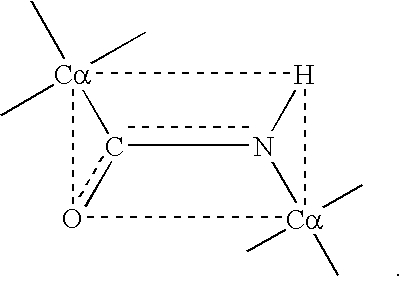[0112] It should be understood that all predetermined values and constants given in the equations above are determined within the constraints of current understandings of
protein ligand interactions with particular regard to the type of computation being undertaken herein. Therefore, it is possible that, as this scoring function is refined further, these values and constants may change hence any suitable numerical value which gives the desired results in terms of estimating the
binding energy of a protein to a ligand may be used and hence fall within the scope of the present invention. As described above, the scoring function is applied to data extracted from the
database of side-chain conformations, atom identities, and interatomic distances. For the purposes of the present description, the number of
MHC Class II molecules included in this
database is 42 models plus four solved structures. It should be apparent from the above descriptions that the modular nature of the construction of the computational method of the present invention means that new models can simply be added and scanned with the
peptide backbone
library and side-chain conformational
search function to create additional data sets which can be processed by the
peptide scoring function as described above. This allows for the
repertoire of scanned
MHC Class II molecules to easily be increased, or structures and associated data to be replaced if data are available to create more accurate models of the existing alleles. The present prediction method can be calibrated against a
data set comprising a large number of peptides whose affinity for various
MHC Class II molecules has previously been experimentally determined. By comparison of calculated versus experimental data, a
cut of value can be determined above which it is known that all experimentally determined T-
cell epitopes are correctly predicted. It should be understood that, although the above scoring function is relatively simple compared to some sophisticated methodologies that are available, the calculations are performed extremely rapidly. It should also be understood that the objective is not to calculate the true
binding energy per se for each
peptide docked in the binding groove of a selected MHC Class II protein. The underlying objective is to obtain comparative
binding energy data as an aid to predicting the location of T-cell epitopes based on the primary structure (i.e.
amino acid sequence) of a selected protein. A relatively high binding energy or a binding energy above a selected threshold value would suggest the presence of a T-cell
epitope in the ligand. The ligand may then be subjected to at least one round of amino-acid substitution and the binding energy recalculated. Due to the rapid nature of the calculations, these manipulations of the
peptide sequence can be performed interactively within the program's
user interface on cost-effectively available
computer hardware. Major investment in
computer hardware is thus not required. It would be apparent to one skilled in the art that other available
software could be used for the same purposes. In particular, more sophisticated
software which is capable of docking ligands into protein binding-sites may be used in conjunction with
energy minimization. Examples of docking
software are: DOCK (Kuntz et al., J. Mol. Biol., 161:269-288 (1982)), LUDI (Bohm, H. J., J. Comput Aided Mol. Des., 8:623-632 (1994)) and FLEXX (Rarey M., et al., ISMB, 3:300-308 (1995)). Examples of molecular modeling and manipulation software include: AMBER (Tripos) and CHARMm (Molecular Simulations Inc.). The use of these computational methods would severely limit the
throughput of the method of this invention due to the lengths of
processing time required to make the necessary calculations. However, it is feasible that such methods could be used as a `secondary screen` to obtain more accurate calculations of binding energy for peptides which are found to be `positive binders` via the method of the present invention. The limitation of
processing time for sophisticated molecular mechanic or molecular dynamic calculations is one which is defined both by the design of the software which makes these calculations and the
current technology limitations of
computer hardware. It may be anticipated that, in the future, with the writing of more efficient code and the continuing increases in speed of computer processors, it may become feasible to make such calculations within a more manageable time-frame. Further information on energy functions applied to macromolecules and consideration of the various interactions that take place within a folded
protein structure can be found in: Brooks, B. R., et al., J. Comput. Chem., 4:187-217 (1983) and further information concerning general protein-ligand interactions can be found in: Dauber-Osguthorpe et al., Proteins4(1):31-47(1988), which are incorporated herein by reference in their entirety. Useful
background information can also be found, for example, in Fasman, G. D., ed., Prediction of
Protein Structure and the Principles of
Protein Conformation, Plenum Press, New York, ISBN: 0-306 4313-9.
 Login to View More
Login to View More 
